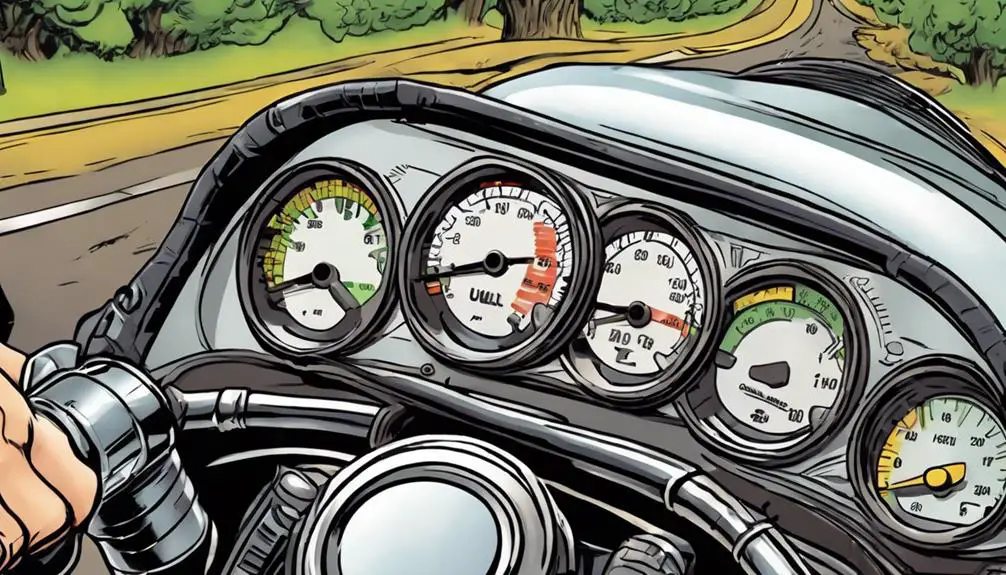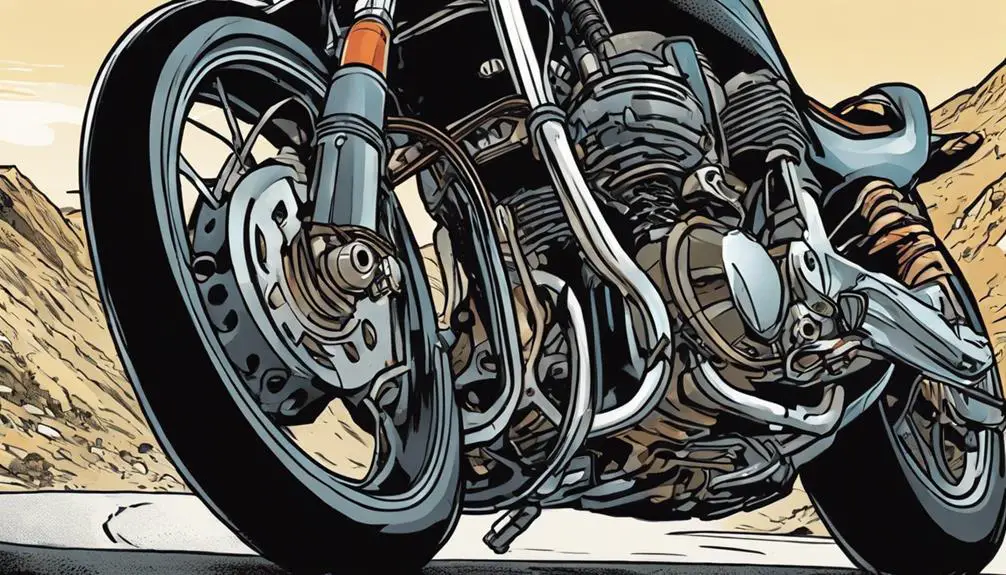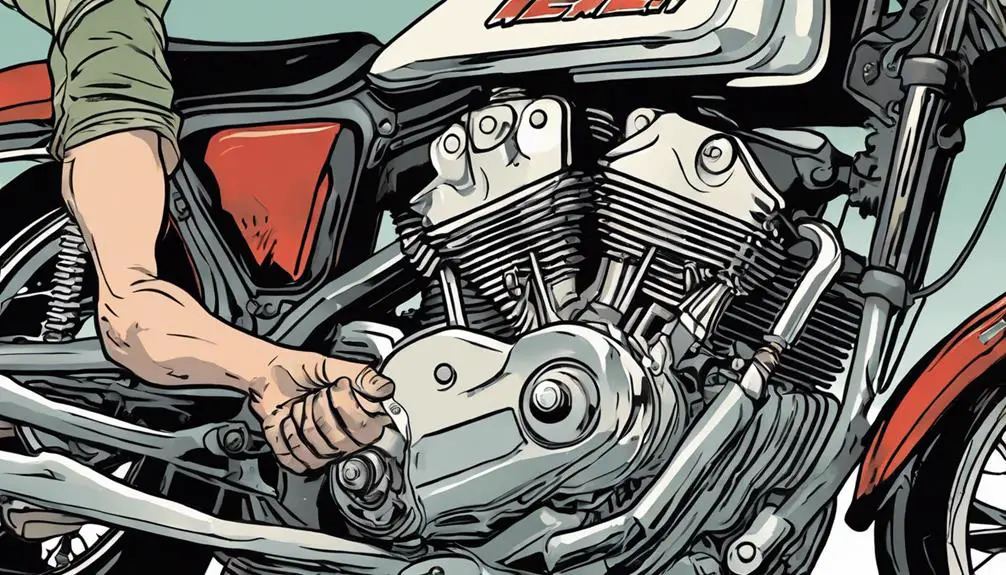When it comes to evaluating motorcycle performance features, it's all about finding the right balance. You'll want to start by considering key metrics like horsepower and torque, as they play an essential role in how your bike responds on the road. Don't overlook the weight-to-power ratio, which can greatly affect agility and speed. As you examine the suspension and braking systems, you'll notice that not all bikes handle the same way. Understanding these elements will lead you to make an informed choice, but there's more to explore before you hit the throttle.
Quick Takeaways
- Assess horsepower and torque ratings to understand speed potential and acceleration capabilities of the motorcycle.
- Evaluate the weight-to-power ratio, as lighter bikes with higher horsepower enhance handling and responsiveness.
- Examine the suspension system type and adjustability, which significantly impacts comfort and traction on various terrains.
- Review the braking system features, including ABS and rotor size, to ensure effective stopping power and rider control.
Key Performance Metrics

When evaluating a motorcycle's performance, you'll want to focus on key metrics like horsepower, torque, and weight-to-power ratio. These factors are essential in determining how your ride will feel on the open road.
Horsepower gives you a sense of how fast you can go; the higher the number, the more exhilarating your experience will be. Torque, on the other hand, is about acceleration. It tells you how quickly you can reach that liberating speed, especially when you need to navigate tight turns or merge onto highways.
Next up is the weight-to-power ratio, which is a game-changer. Lighter bikes with higher horsepower can deliver that rush of freedom you crave, allowing you to feel the wind in your face as you take off.
A lower weight-to-power ratio usually means better handling and responsiveness, making your ride more enjoyable.
Engine Specifications
Understanding engine specifications is essential for evaluating a motorcycle's overall performance and how it fits your riding style. The heart of your ride lies in the engine, so pay attention to key elements like displacement, power output, and torque.
Displacement, measured in cubic centimeters (cc), gives you an idea of the engine's size and potential. Larger engines generally provide more power, which translates to a thrilling ride, but it can also affect fuel efficiency.
Next, look at horsepower and torque ratings. Horsepower reflects your bike's ability to reach higher speeds, while torque indicates the force that gets you moving from a standstill. If you crave quick acceleration and agile handling, a well-balanced power-to-weight ratio is vital.
Additionally, consider the engine type—whether it's a single-cylinder, parallel-twin, or V-twin. Each type offers a different riding experience, from the raw power of a V-twin to the nimble feel of a single.
Suspension and Handling

A motorcycle's suspension and handling directly influence your riding experience, affecting comfort, control, and stability on various terrains.
When you hit the open road, the suspension system plays an essential role in absorbing bumps and maintaining traction. If you want to feel liberated as you navigate twists and turns, focus on how well the suspension keeps your wheels planted.
Consider the type of suspension—whether it's telescopic forks, mono-shock, or a combination—and how it affects your ride. You'll want a setup that offers both comfort for long journeys and responsiveness for spirited rides. Pay attention to the adjustability of the suspension too; being able to tweak settings can enhance your connection with the bike, allowing you to tailor it to your riding style.
Handling ties closely to the motorcycle's geometry and weight distribution. A well-balanced bike provides confidence when cornering and maneuvering through traffic. Take the time to test ride different models, feeling how they respond to your inputs.
Braking Systems
Braking systems are essential for your safety and control, directly impacting how well you can slow down or stop on demand. When you're out on the open road, feeling that rush of freedom, you want to know your bike can respond instantly when you squeeze the lever.
Look for bikes equipped with modern brake technologies like anti-lock braking systems (ABS), which prevent wheel lock-up during hard braking, giving you more confidence in tricky situations.
Evaluate the brake components themselves—calipers, rotors, and pads. Larger rotors often provide better heat dissipation, which means more consistent performance during long rides. Don't overlook the importance of brake feel; a firm, responsive lever can make all the difference in how you control your motorcycle.
Consider how the braking system works with the overall design of the bike. Does it give you a sense of balance and stability? A well-integrated braking system enhances your liberation, allowing you to navigate any curve or obstacle with ease.
Ultimately, you want a braking system that feels like an extension of your will, empowering you to ride freely while staying safe.
Common Issues and Solutions

Common issues with motorcycle performance can often be traced back to maintenance oversights or component wear, so it's crucial to stay vigilant.
If you're feeling a loss of power or sluggish acceleration, check your air filter and fuel lines. Clogged filters restrict airflow, while dirty fuel lines can starve your engine. Regularly clean or replace these components to reclaim that exhilarating ride.
Another common problem is brake performance. If you notice squeaking or reduced stopping power, it's time to inspect your brake pads and fluid levels. Worn pads can lead to dangerous situations, so replace them as needed. Don't forget to bleed your brake lines to keep the system responsive.
Tire wear also plays a critical role in performance. Feel a wobble or vibration? It might be time for new tires or a wheel alignment. Proper tire pressure and tread depth are key to maintaining grip and control.
Common Questions
How Does Rider Weight Affect Motorcycle Performance?
Rider weight plays a significant role in motorcycle performance. If you're lighter, you'll experience quicker acceleration and easier handling.
On the flip side, a heavier rider might find stability and traction improve, especially in corners. It's all about balance.
You can feel the difference in responsiveness and comfort based on your weight. So, whether you're carving through turns or cruising, your weight directly influences how your ride performs.
What Role Does Tire Choice Play in Performance?
Tire choice plays a vital role in your motorcycle's performance.
When you select tires, consider their grip, durability, and type—each affects handling and stability. A sticky tire offers better traction, especially in corners, while a touring tire might provide more comfort for long rides.
Always match your tire choice to your riding style and conditions; this way, you can release your bike's full potential and enjoy the freedom of the open road.
How Can I Improve My Riding Skills for Better Performance?
Imagine slicing through the wind, feeling free as a bird—improving your riding skills can take you there.
Start by practicing in different conditions; it'll sharpen your reflexes and boost your confidence.
Focus on body positioning and throttle control; they're your best friends on the road.
Join a riding group to learn from others and share experiences.
Are Aftermarket Parts Worth the Investment for Performance?
When considering aftermarket parts, you've gotta weigh the pros and cons.
If you're chasing enhanced performance, these upgrades can definitely boost your ride's power and handling. However, not all parts deliver the same value.
It's crucial to research and choose quality components that align with your riding style. Investing wisely can lead to a more exhilarating experience, but always remember to balance cost with the benefits you'll gain from the upgrades.
How Does Weather Impact Motorcycle Performance on the Road?
You might think weather's just a backdrop for your ride, but it seriously affects motorcycle performance.
Rain can reduce traction, making it tricky to handle curves, while extreme heat can lead to overheating engines.
Cold weather can thicken oil, reducing efficiency.
Understanding these impacts empowers you to choose the right gear and adjust your riding style, ensuring you enjoy the freedom of the open road, no matter the conditions.
Stay aware, stay free!
Wrapping Up
In the thrilling world of motorcycles, mastering the metrics matters. By balancing horsepower, handling, and braking brilliance, you're bound to boost your biking bliss.
Don't forget to delve into the details, from engine specs to suspension systems, ensuring your ride feels just right.
So, gear up and glide into your next adventure, confident in your choices.
With careful consideration, you'll conquer the curves and enjoy every exhilarating experience on the open road!